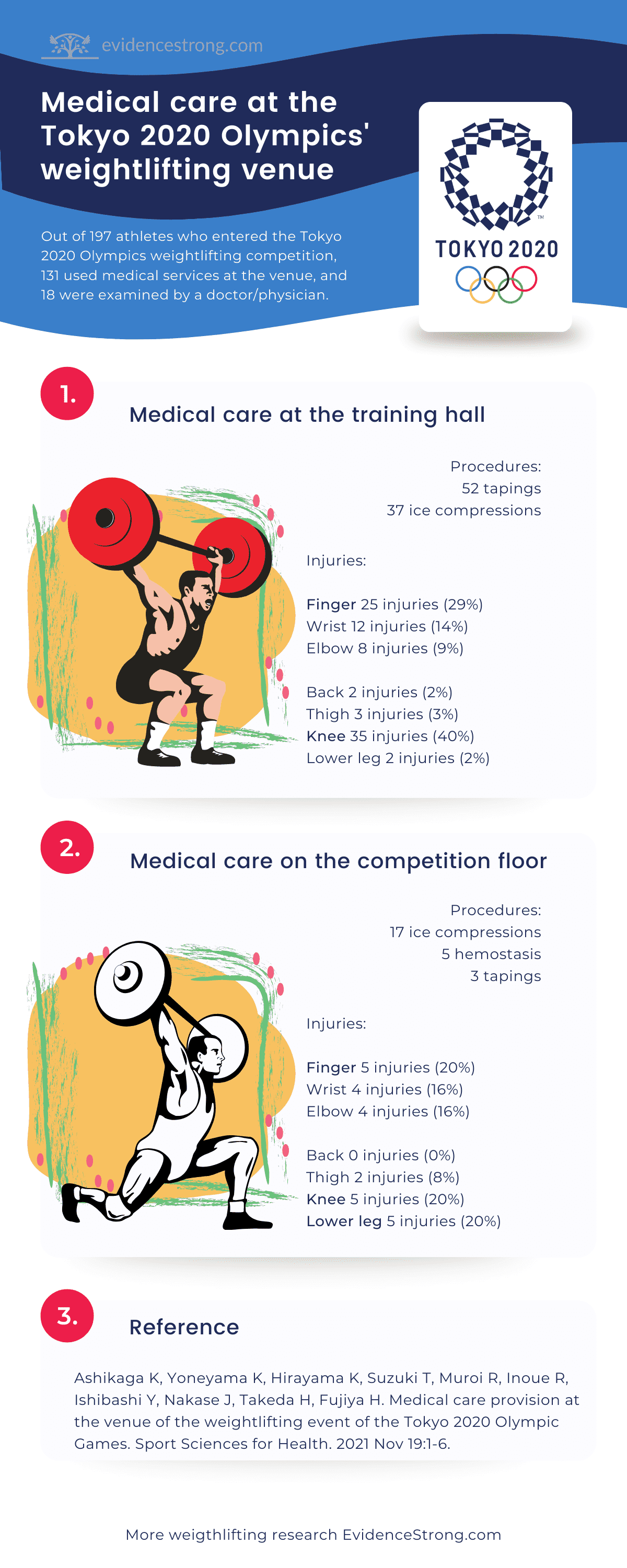Summary of an article presenting medical care statistics from the Tokyo 2020 Olympics’ weightlifting venue.
Who
194 (out of 197 who entered) athletes competing in the Tokyo 2020 Olympics’ weightlifting event in 14 classes (7 women, 7 women), 14 athletes per weight class (15 in men 96’s including a refugee athlete) (Japan).
Design
Observational study of the medical care provided in the training hall and competition venue of Tokyo 2020 Olympics’ weightlifting event (not in all medical centers, e.g., policlinic)
Outcome measures
- injury and illness care provided at the weightlifting training and competition venues (e.g., first-aid stations, medical stations, IF station).
first-aid station – had at least one athletic trainer, physical therapist, or a nurse; 1 situated at the training hall, 2 at the competition warm-up area.
medical station – had at least one doctor and one physical therapist; 1 at the training hall, 1 at the competition warm-up area.
IF station – had one IF physician, one host nation physician, and one athletic trainer or physical therapist; 1 at the competition warm-up area.
Main results
131 athletes used medical care services, but only 18 athletes (8 females) required to be examined by a doctor/physician. 9 athletes (3 females) were examined during the competition.
Symptoms reported at medical stations:
- headache 2 athletes
- light-headedness 2 athletes
- knee pain 2 athletes
- diarrhea 1 athlete
- chest pain & dyspnoea 1 athlete
- panic attack 1 athlete
- elbow pain 1 athlete
- hip pain 1 athlete
- shin pain 1 athlete
- lower leg abrasion 1 athlete
- finger bleeding 1 athlete
- ankle pain 1 athlete
- thigh pain 1 athlete
- nose-wing inflammation 1 athlete
training hall first-aid care:
89 medical procedures (51 on females) were performed, including:
- 52 tapings
- 37 ice compressions
most injured body parts:
- knee - 35 injuries (40.2%)
- finger - 25 injuries (28.7%)
- wrist - 12 injuries (13.8%)
- elbow - 8 injuries (9.2%)
- thigh - 3 injuries (3.4%)
- lower leg - 2 injuries (2.3%)
- back - 2 injuries (2.3%)
procedures by country:
- Turkmenistan - 21 procedures (23.6%)
- Cameroon - 18 procedures (20.2%)
- Cuba - 11 procedures (12.4%)
- Ghana - 7 procedures (7.9%)
- Lebanon - 5 procedures (5.6%)
- others - 27 procedures (30.3%)
competition floor first-aid care:
- 25 medical procedures (16 on females) were performed, including:
- 17 ice compressions
- 5 haemostasis (stopping bleeding)
- 3 tapings
- body parts injured:
- finger, knee, lower leg - 5 injuries (20%)
- wrist, elbow - 4 injuries (16%)
- thigh - 2 injuries (8%)
- procedures by country:
- Japan - 3 (12%)
- Korea - 3 (12%)
- Georgia - 3 (12%)
- other - 13 (52%)
- 25 medical procedures (16 on females) were performed, including:
Take home message
Original article
Ashikaga K, Yoneyama K, Hirayama K, Suzuki T, Muroi R, Inoue R, Ishibashi Y, Nakase J, Takeda H, Fujiya H. Medical care provision at the venue of the weightlifting event of the Tokyo 2020 Olympic Games. Sport Sciences for Health. 2021 Nov 19:1-6.
You might want to read next
Which weightlifting shoe won the most medals at the Tokyo Olympics?
Training cues and craziness culture in Georgian Olympic weightlifting
